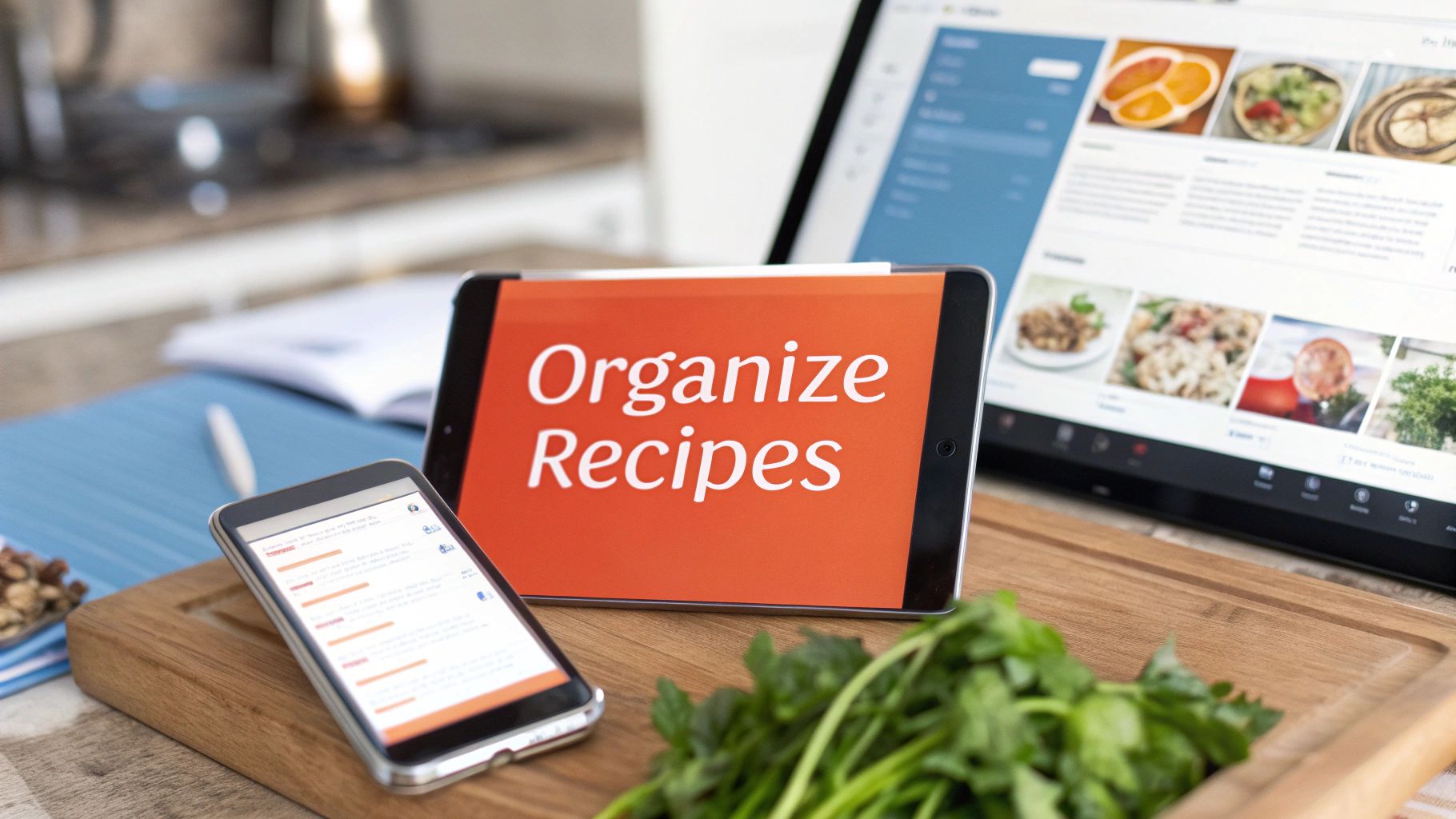Why Digital Recipe Chaos Is Holding You Back
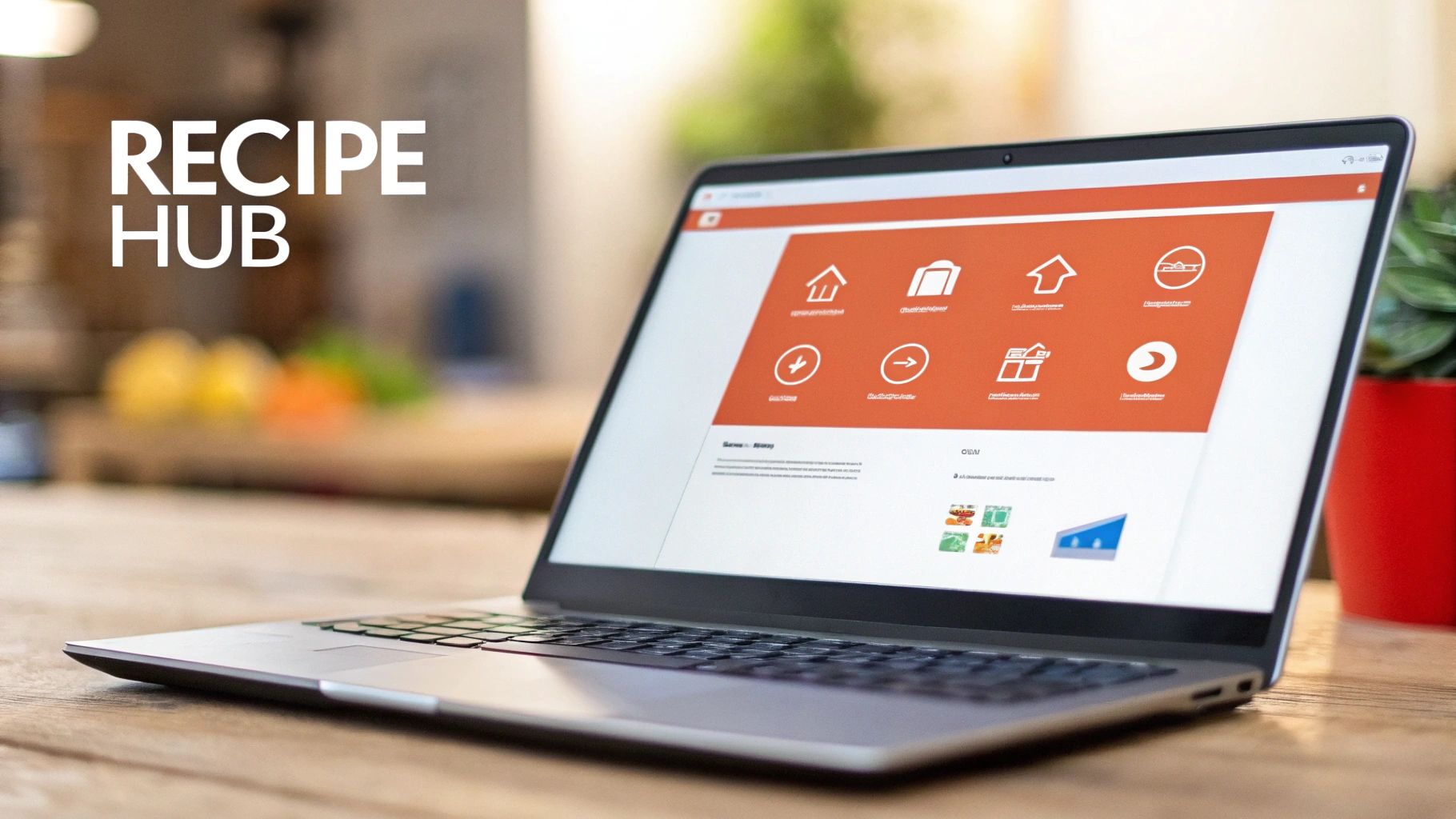
Let's be honest, finding recipe inspiration online is easy. Between food blogs, social media, and dedicated cooking websites, there's a constant stream of delicious ideas. But this abundance can quickly become overwhelming, creating digital recipe chaos. It's a common problem for home cooks everywhere.
The Problem of Scattered Recipes
Most of us save recipes across multiple platforms. We might bookmark a website, screenshot an Instagram post, or save a recipe to a dedicated cooking app. This creates a fragmented and disorganized system. Finding a specific recipe later can feel impossible.
This scattered approach leads to frustration and wasted time. Imagine scrolling through hundreds of saved images just to find that one pasta dish. Meal planning becomes a chore instead of a joy.
Additionally, we often save the same recipe multiple times from different sources. This recipe redundancy further clutters our digital space and adds to the overall chaos. Good organization can solve this problem and create a manageable culinary library.
The Benefits of Organized Recipes
Moving from digital chaos to an organized system has real benefits. When your recipes are well-organized, meal planning becomes much simpler. You can quickly browse your categorized collection, create shopping lists, and plan meals in advance. This saves time and reduces stress.
A well-organized system also helps you rediscover old favorites. Remember that chicken dish you saved months ago? With an organized system, you can easily find it again. This adds variety and excitement to your meals. The popularity of recipe apps reflects this desire for better organization.
In fact, the global recipe apps market is booming. Currently valued at USD 5.80 billion, the market is projected to reach USD 14.27 billion by 2033. This represents a CAGR of 10.52% between 2025 and 2033. You can find more statistics here: Learn more about the recipe apps market growth. Effective organization transforms your recipes from a source of stress into a valuable tool.
The Digital Recipe Box: Apps That Actually Work
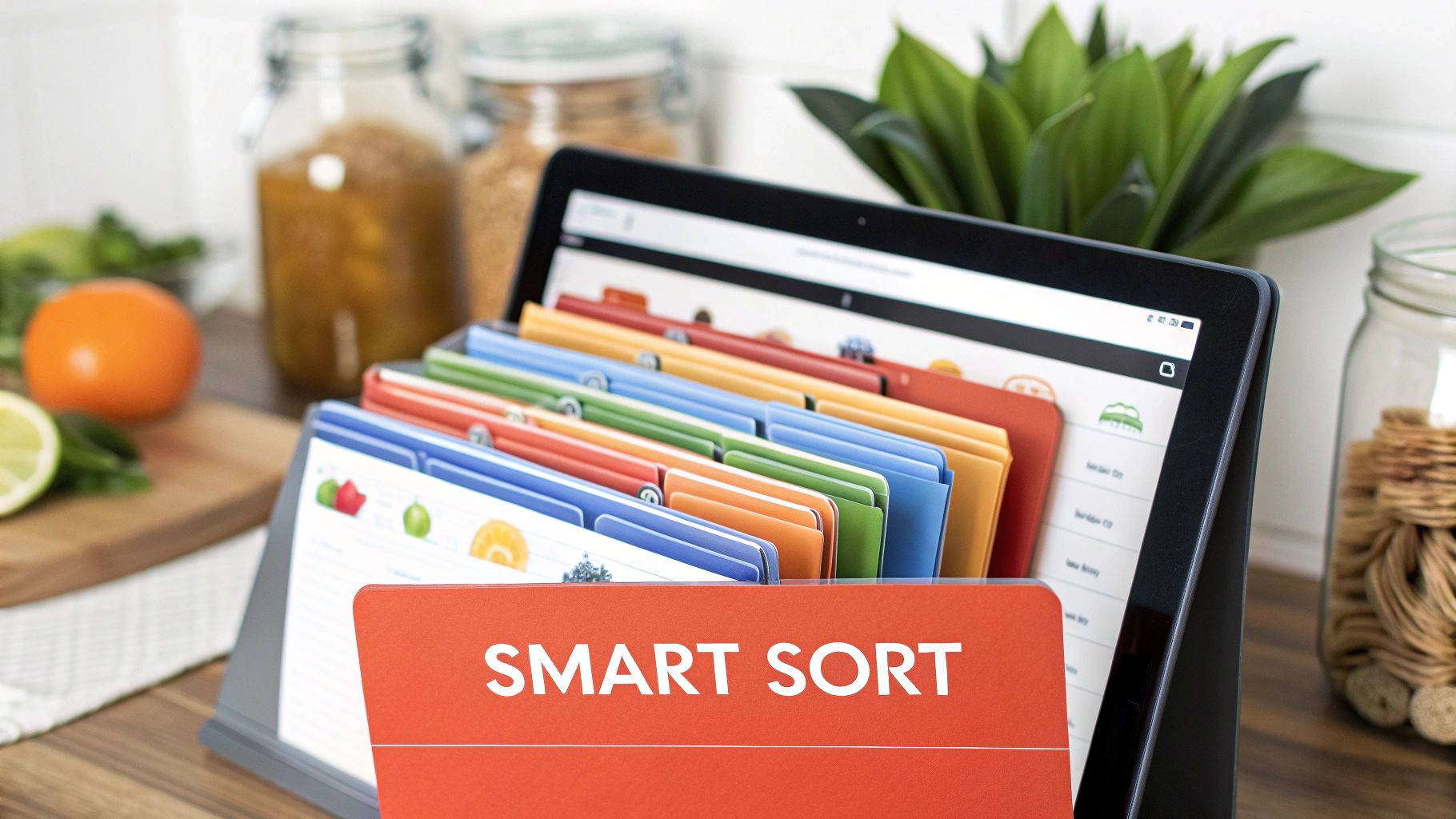
Tired of screenshots and bookmarked links? It's time to embrace the power of digital recipe organization. Numerous apps can transform your scattered recipes into a centralized culinary hub. But with so many choices, finding the right fit can be challenging.
Dedicated Recipe Organizers: Paprika and ChefTap
For those who constantly gather recipes online, dedicated recipe organizers like Paprika and ChefTap offer a seamless experience. These apps streamline the process of importing and managing your digital recipe collection.
-
Automated Recipe Importing: Simply paste the URL, and the app does the rest, pulling the title, ingredients, and instructions.
-
Built-in Browsers: Browse and save recipes directly within the app.
-
Cross-Device Syncing: Access your recipes on your phone, tablet, or computer.
-
Offline Access: No internet? No problem! Cook your favorite dishes even without a connection.
Paprika and ChefTap create a centralized and organized system, making online recipe management simple and efficient. These apps are a great choice for anyone who wants a dedicated solution for their digital recipes.
Customizable Systems for Recipes: Notion
For the cook who wants ultimate flexibility, Notion offers a powerful alternative. While not strictly a recipe app, Notion's customizable features allow you to create a system that perfectly matches your workflow.
-
Customizable Databases: Track ingredients, cooking times, cuisine types, and anything else you desire.
-
Tagging and Filtering: Find recipes quickly using tags like "vegetarian," "quick meals," or "family favorites."
-
Relational Databases: Link recipes to meal plans, grocery lists, and other related information.
-
Flexible Templates: Adapt existing templates or design your own from scratch.
Notion empowers you to organize not just recipes, but your entire culinary world. Learn more about digital organization with various tools and techniques: How to master digital recipe organization with a variety of tools and techniques. However, this flexibility comes with a slightly steeper learning curve.
To help you choose the best app, we've created a comparison table highlighting the key features and pricing of some popular recipe organization apps.
Top Recipe Organization Apps Comparison
Detailed comparison of popular recipe organization applications based on key features and pricing
| App | Free Version | Recipe Import | Meal Planning | Grocery Lists | Price (Premium) |
|---|---|---|---|---|---|
| Paprika | Limited | Yes | Yes | Yes | Paid |
| ChefTap | Limited | Yes | Yes | Yes | Paid |
| Notion | Available | Manual | Yes | Yes | Paid (Optional) |
As this table shows, dedicated apps offer streamlined recipe importing, while Notion provides greater flexibility at the cost of manual entry.
Choosing the Right App for You
Finding the perfect recipe organizer comes down to your individual needs and preferences. Paprika or ChefTap are excellent choices if you regularly collect online recipes and prefer a simple experience. Notion offers a customizable system that integrates with other aspects of your life.
Consider factors like ease of use, features, and pricing. Some apps have free versions with limited features, while others require a subscription. Experimenting with different options is essential for finding the right digital recipe box for you. A well-organized recipe collection can transform your cooking experience, making it more enjoyable and efficient.
Building Your Personal Recipe Organization System
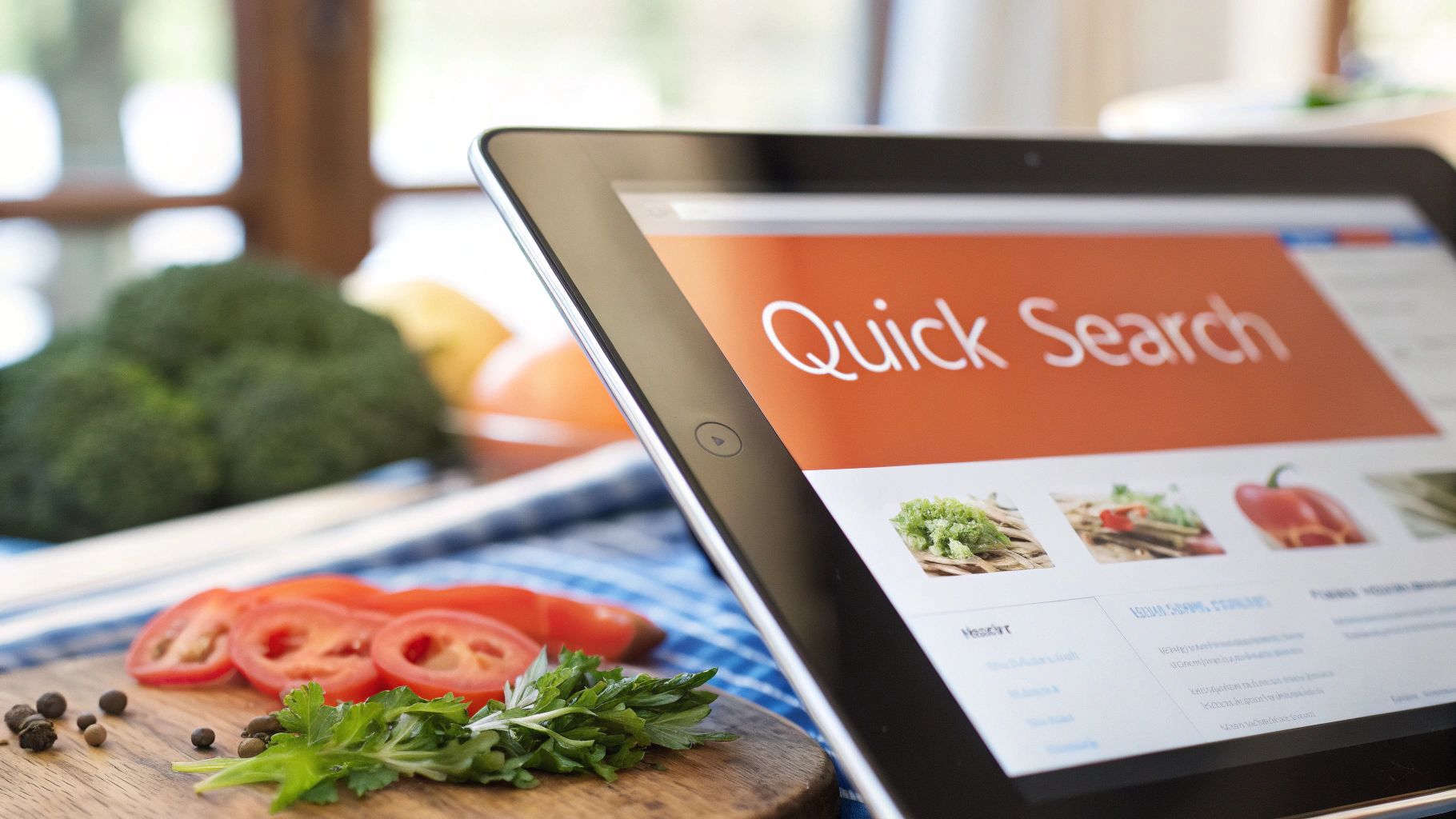
Choosing the right recipe app is only the beginning. For a truly efficient system, you need to personalize your online recipe organization. This means thinking beyond the standard categories and developing a framework that works best for you.
Categorization Strategies Beyond the Basics
Most apps offer basic categories like "Breakfast," "Lunch," and "Dinner." But these broad categories might not be the most useful for your needs. Think about how you choose recipes. If you often select recipes based on how you want to cook, organizing by cooking method might be more helpful. Examples include "Grilling," "Baking," or "One-Pot Meals."
You could also categorize recipes by preparation time. "Quick Meals" and "Weekend Projects" are good examples. Or, you could categorize by key ingredients, such as "Chicken Dishes" or "Vegetarian." This makes finding recipes that fit your schedule and the ingredients you have on hand much easier. Efficient meal planning becomes a breeze. For more tips, check out this article on how to master recipe organization.
Smart Tagging for Instant Discoverability
Tags provide another layer of organization, allowing you to search by specific criteria. Think of tags as keywords that describe your recipes in more detail. For example, a "Chicken Stir-Fry" recipe could have tags like "Asian Cuisine," "Weeknight Dinner," "Gluten-Free," and "Spicy."
A consistent tagging system makes finding recipes incredibly easy. Imagine craving comfort food and instantly finding all your cozy casserole and soup recipes. That's the power of well-implemented tags.
Standardized Naming and Personal Modifications
Using consistent naming conventions is also important. It keeps your recipe collection organized and easy to navigate. For example, always use "Chicken Tikka Masala" instead of sometimes using "Chicken Tikka" or "Tikka Masala." This consistency will help you quickly find what you're looking for.
Don't forget to document any personal modifications you make to recipes. This turns your digital collection into your own personalized cookbook. It's a great way to capture your cooking experience and taste preferences.
Backups: Protecting Your Culinary Treasures
Recipe websites are constantly growing. In 2023, the global market for recipe websites was valued at roughly USD 5 billion. Projections show this market reaching USD 9.2 billion by 2033, with a CAGR of 6.3%. Factors like online platforms, specific dietary needs, and the influence of food bloggers are driving this growth. You can find more detailed statistics here. However, websites can disappear, and technical issues can arise. Regularly backing up your recipe collection is essential for protecting your carefully curated recipes. Whether you use cloud storage or a local backup, ensuring your recipes are safe from loss is a smart move. A well-organized and protected recipe collection allows you to enjoy cooking without worrying about digital disasters.
Capturing Social Media Recipes Before They Disappear
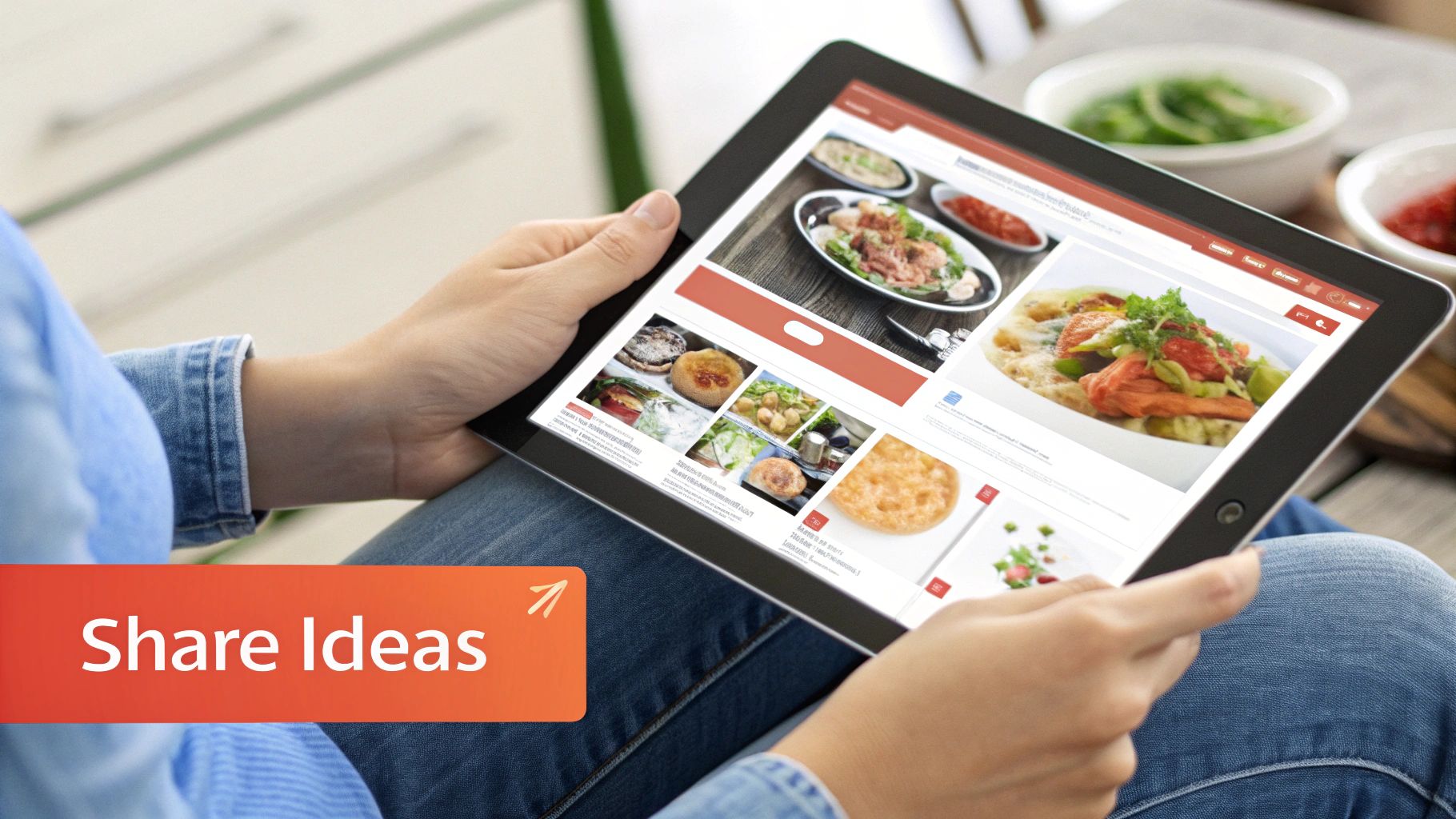
Social media platforms like TikTok and Instagram have become incredible sources of culinary inspiration. But the fast-paced nature of these platforms makes it tricky to keep track of all the delicious recipes you come across. A structured approach to saving and organizing these online recipes is key. This means moving beyond screenshots and using tools designed to capture these fleeting culinary gems. You might find this helpful: How to stay on top of social media food trends.
Taming the Fleeting Inspiration: Tools and Techniques
Think about those eye-catching TikTok cooking videos and beautifully presented Instagram stories. They're packed with ideas, but often lack the detailed instructions you need to recreate the dish. This is where browser extensions and note-taking apps can be incredibly useful.
Some browser extensions can seamlessly transfer recipe information directly into your preferred recipe management app. Others let you quickly capture video stills and jot down important steps, preserving the core elements of the recipe.
For example, if you see a quick pasta recipe on an Instagram story, instead of a rushed screenshot, a recipe-saving extension can capture the ingredients and instructions instantly. It's ready to be added to your organized collection, saving you time and ensuring you have all the details in one convenient location.
Extracting Details from Video Content
Video recipes present a unique set of challenges. Key details are often embedded within the visuals or rapid-fire commentary. This means you need to watch actively and take strategic notes.
Develop a system for pausing and rewinding, noting ingredient quantities and timings. Some people find it helpful to use a two-column note-taking method. They capture visual cues on one side and verbal instructions on the other. This careful observation is essential for transforming social media inspiration into practical recipes you can easily repeat.
Standardizing Imprecise Measurements
Casual cooking content often uses imprecise measurements like "a handful" or "a pinch." These descriptions can be charming, but also frustrating when you're trying to achieve consistent results.
As you save social media recipes, convert these approximations into standard units of measurement. This ensures accuracy and allows you to refine the recipe over time, creating your own personalized version.
Organizing Recipes from Private Groups and Messages
Don’t forget about the hidden culinary treasures found in private social media groups and direct messages. The same capture techniques apply here. Screenshot important instructions, transcribe shared text, and standardize any imprecise measurements.
This preserves valuable family recipes and community-shared creations, integrating them seamlessly into your organized collection. By actively capturing and organizing social media recipes, you turn fleeting inspiration into a valuable and accessible part of your culinary repertoire.
The Rise of Digital Recipe Consumption
The impact of social media on cooking is undeniable. Platforms like Instagram, TikTok, and YouTube have become essential for discovering and sharing culinary content. As of 2024, the digital recipe consumption market was valued at USD 625.91 million.
It’s projected to reach USD 1,706.30 million by 2031, with a CAGR of 15.40%. This growth is driven by factors like better internet access, the influence of social media influencers, and the rise of smart kitchen appliances. These connected devices make accessing recipes even easier, further increasing engagement with digital platforms. Explore this topic further: Find more detailed statistics here.
From Organized Recipes to Effortless Meal Plans
Having an organized online recipe collection is a great start. But how do you turn those recipes into actual meals? This is where meal planning comes in. It’s about transforming your digital recipes into a powerful tool for eliminating weeknight stress and enjoying delicious, home-cooked meals.
Building Balanced Weekly Menus
Your organized recipe collection is the foundation for effortless meal planning. Think about your week. What are your schedule constraints? Are there nights when you have more time to cook? Successful meal planners use their organized systems to build balanced weekly menus, considering factors like time and ingredients.
-
Ingredient Overlap: Plan meals that use similar ingredients. This reduces food waste and simplifies your shopping list. For example, if you’re buying spinach for a salad one night, plan to use it in a pasta dish later in the week.
-
Variety is Key: While efficiency is important, don’t sacrifice variety. Your organized collection lets you quickly browse different cuisines and cooking styles. Aim for a mix of flavors and textures throughout the week.
Categorizing Recipes by Complexity
Look at your recipes with a "weekday energy" lens. Categorize them by complexity:
-
Quick & Easy: Perfect for busy weeknights. These meals require minimal prep and cook time (think 30 minutes or less).
-
Moderate Effort: Dishes that require a bit more time or attention, suitable for less hectic evenings.
-
Weekend Projects: More complex or time-consuming recipes that you can enjoy when you have more time.
Matching recipe complexity with your realistic weekday energy levels prevents cooking fatigue and ensures you actually use your organized recipes.
Implementing a Flexible Planning Framework
Life happens. Unexpected schedule changes can disrupt even the most organized week. That’s why a flexible planning framework is essential.
-
Swappable Meals: Design your meal plan with flexibility. Can Tuesday’s dinner easily be swapped with Thursday’s? This allows you to adapt to changes without last-minute scrambling.
-
Leftover Integration: Strategically plan for leftovers. Roast a larger chicken on Sunday and use it in salads, sandwiches, or soups throughout the week. Your recipe collection can help you find creative ways to use those leftovers.
Incorporating Dietary Needs and Preferences
Consider dietary restrictions and preferences. If you have family members with allergies or dislikes, your organized system is crucial. Use tags and categories to filter recipes that meet everyone’s needs.
- Seasonal Eating: Incorporate seasonal ingredients. This adds variety and often reduces grocery costs. Use your tagging system to quickly find recipes featuring seasonal produce.
To illustrate how a flexible framework can work, let's look at a sample meal planning template. This table provides a simple structure to organize your weekly meals, emphasizing recipe categories for variety and efficiency.
Weekly Meal Planning Template
Sample meal planning framework based on organized recipe categories to reduce planning time and increase variety
| Day | Meal Type | Recipe Category | Prep Time | Planning Considerations |
|---|---|---|---|---|
| Monday | Dinner | Quick & Easy (Pasta) | 30 minutes | Use leftover roasted vegetables from Sunday |
| Tuesday | Dinner | Moderate Effort (Chicken) | 45 minutes | Can be swapped with Thursday's meal |
| Wednesday | Dinner | Quick & Easy (Salad) | 20 minutes | Incorporate seasonal greens |
| Thursday | Dinner | Moderate Effort (Fish) | 40 minutes | Can be swapped with Tuesday's meal |
| Friday | Dinner | Weekend Project (Pizza) | 1 hour | Dough can be prepped in advance |
| Saturday | Dinner | Quick & Easy (Soup) | 30 minutes | Use leftover chicken from Tuesday |
| Sunday | Dinner | Weekend Project (Roast) | 1.5 hours | Roast extra vegetables for Monday |
This table demonstrates how categorizing recipes and considering leftovers can make meal planning easier. By planning ahead and utilizing your organized recipe system, you can significantly reduce weeknight stress.
One useful extension to recipe organization is generating a grocery list directly from your recipes. This process is detailed in a guide on recipe to grocery list. By implementing these techniques, you can transform your organized recipe collection into a system for stress-free meal planning. This helps you enjoy home-cooked meals more often without the daily dinner dilemma.
Creating Shared Recipe Collections That Last Generations
Family recipes are more than just instructions; they are a tangible connection to our heritage. They tell stories of family gatherings, holiday traditions, and the love shared across generations. Organizing these recipes online requires a thoughtful approach that preserves these stories while ensuring easy access for years to come.
Preserving Handwritten Recipes and Notes
Many cherished family recipes exist as handwritten notes on faded index cards or tucked into well-loved cookbooks. Digitizing these recipes is the first step in preserving them. Take clear photos or scans of each recipe, making sure to capture any handwritten notes or modifications. These seemingly insignificant scribbles often hold the key to a dish's unique flavor and a family's personal touch. For example, a note like "Grandma always added a pinch of nutmeg" provides valuable context and connects the recipe to a specific person and memory.
Collaborative Recipe Libraries That Evolve
Once your recipes are digitized, creating a shared online space allows family members to easily access and contribute to the collection. Cloud-based services like Google Drive or shared recipe apps provide a central hub for these culinary treasures. This ensures everyone has the most up-to-date versions. Collaborative features allow younger generations to add their own adaptations and variations, creating a living, evolving family cookbook. This intergenerational exchange keeps traditions alive while allowing for personal expression.
Organizing for Holidays and Celebrations
Family recipes are often tied to specific holidays or celebrations. Create dedicated collections within your shared library for events like Thanksgiving, Christmas, or family birthdays. This simplifies finding recipes for special occasions and reinforces the connection between food and memory. Include photos of past gatherings or anecdotes about the dishes. This adds another layer of meaning to the recipes and transforms a simple collection into a rich tapestry of family history.
Cloud-Based Solutions for Sharing and Adapting
Cloud-based platforms offer a dynamic way to manage and share family recipes. Grandparents can share time-honored techniques while younger family members contribute modern adaptations, all within the same digital space. This fosters a vibrant exchange of culinary knowledge and ensures that family recipes remain relevant for future generations. A helpful addition to your recipe organization is generating a grocery list directly from your recipes. You can learn more about this process in a guide on recipe to grocery list. These digital platforms make it easy to share, adapt, and preserve the essence of family cooking.
Troubleshooting Your Recipe Organization System
Even the best-laid plans for organizing your recipes can hit a snag. From broken links and disappearing blogs to updated recipes and software limitations, real-world issues can disrupt even the most organized digital recipe system.
Common Problems and Solutions
It's important to be prepared for problems like broken links or recipes that have vanished. Thankfully, there are simple solutions you can use to keep your online recipe organization running smoothly.
-
The Vanishing Recipe: Websites sometimes disappear, taking your saved recipes with them. The Solution: If a recipe vanishes, try the Internet Archive's Wayback Machine. This helpful tool can often retrieve older web pages, possibly recovering your lost recipe.
-
The Paywall Predicament: Some recipe sites put their content behind paywalls. The Solution: Look for free versions of the recipe. Many popular dishes have variations on free sites. Also, check if your local library offers access to recipe databases.
-
Format Frustrations: Copying and pasting from different sources can create formatting inconsistencies. The Solution: Create a standard format for your recipes. Use a consistent font, font size, and heading style for visual appeal and easy reading.
-
Duplicate Recipe Dilemma: Saving the same recipe multiple times creates clutter. The Solution: Regularly review your collection and remove duplicates. Use tags or categories to find redundant entries.
Maintaining System Integrity: Tips and Tricks
Like any well-organized system, your recipe collection needs regular maintenance. These practices help prevent it from becoming a digital burden:
-
Regular Backups: Data loss can be devastating. Back up your recipes to cloud storage like Google Drive or Dropbox or an external drive. This is crucial regardless of your method, whether it's an app, spreadsheet, or document system.
-
Link Checking: Check for broken links regularly. Broken links are frustrating when you’re ready to cook. Use browser extensions or online tools to scan for broken links in your saved recipes.
-
Software Updates: Keep your apps or software updated. Updates often include bug fixes, new features, and security improvements.
App-Specific Troubleshooting and Migration Strategies
Switching apps can be daunting. You've put effort into your collection, and starting over is discouraging. Fortunately, most apps offer data export. This helps you migrate your recipes without losing your work.
For app-specific problems, check the app's help resources. Most apps offer FAQs, user forums, or customer support.
For migration, look for export options in the app’s settings. Many apps export data in formats like CSV or XML, letting you import recipes into a new platform. If direct import isn’t an option, manually transferring the recipes might be best.
